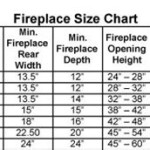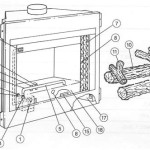Cast Iron Fireplace Paint: Preservation and Restoration
Cast iron fireplaces represent a significant architectural feature in many homes, ranging from Victorian-era residences to more contemporary spaces seeking a touch of historical charm. Preserving and restoring these fireplaces often involves addressing surface degradation, such as rust, flaking paint, and general wear and tear. A crucial aspect of this process is selecting and applying appropriate cast iron fireplace paint, a specialized coating formulated to withstand high temperatures and provide a durable, aesthetically pleasing finish.
The purpose of cast iron fireplace paint extends beyond mere aesthetics. It acts as a protective barrier, shielding the cast iron from further corrosion and degradation. This specialized paint is engineered to endure the cyclical heating and cooling inherent in fireplace use, preventing cracking, peeling, and blistering. Therefore, choosing the right type of paint and applying it correctly are paramount to the long-term preservation of the fireplace.
Before embarking on a painting project, assessing the condition of the cast iron is essential. This involves identifying the type and extent of any existing damage, such as rust, cracks, or loose paint. A thorough examination will inform the preparation process and the selection of the most suitable paint. Neglecting this preliminary assessment can lead to unsatisfactory results and potentially compromise the integrity of the fireplace.
Surface Preparation: A Foundation for Lasting Results
Proper surface preparation is arguably the most important step in ensuring a successful paint application. This process typically involves several stages, beginning with the removal of any loose or flaking paint. This can be achieved using a variety of methods, including wire brushing, scraping, and sanding. Power tools, such as angle grinders with wire brush attachments, can expedite the process, but caution must be exercised to avoid damaging the underlying cast iron.
Once the loose paint has been removed, the next step is to address any rust. Rust can be removed chemically, through the use of rust converters, or mechanically, using abrasive methods. Rust converters transform the rust into a stable compound that can be painted over, while mechanical removal involves physically abrading the rust away. The choice of method depends on the severity of the rust and the desired level of surface smoothness.
After the rust has been treated, the surface should be thoroughly cleaned to remove any remaining debris, dust, or grease. A degreasing agent is often necessary to ensure a clean surface for the paint to adhere to. Following cleaning, the surface should be allowed to dry completely before proceeding with the painting process.
Selecting the Right Paint: Understanding Heat Resistance and Finish
The selection of cast iron fireplace paint hinges on its heat resistance and the desired aesthetic finish. Not all paints are created equal, and using standard household paint on a fireplace is highly inadvisable due to its inability to withstand high temperatures. Specialized high-temperature paints are specifically formulated for this purpose, ensuring they will not break down or release harmful fumes when exposed to heat.
These specialized paints come in a variety of finishes, including matte, satin, and gloss. The choice of finish is largely a matter of personal preference, although matte finishes tend to be more forgiving of imperfections in the surface. Gloss finishes, on the other hand, can highlight details and create a more polished look. Consideration should be given to the overall style of the fireplace and the surrounding décor when selecting a finish.
It is essential to consult the manufacturer's specifications regarding the maximum temperature resistance of the paint. Typically, cast iron fireplace paints are designed to withstand temperatures up to 1200 degrees Fahrenheit, which is adequate for most residential fireplace applications. However, for fireplaces that will be subjected to particularly high heat, such as in industrial settings or with prolonged use, a higher temperature-rated paint may be necessary.
Application Techniques: Achieving a Smooth and Durable Coating
The application of cast iron fireplace paint requires attention to detail to ensure a smooth, even, and durable coating. Prior to application, the paint should be thoroughly mixed according to the manufacturer's instructions. This ensures that the pigments and binders are properly dispersed, resulting in a consistent color and finish. The ambient temperature and humidity should also be within the recommended range specified by the paint manufacturer for optimal results.
The paint can be applied using a variety of methods, including brushes, rollers, and spray guns. Brushing is often preferred for intricate детали and areas where precise control is needed. Rollers can be used for larger, flatter surfaces to achieve a uniform coat. Spraying provides the most even application and is particularly suitable for complex shapes and designs, but it requires proper ventilation and safety precautions.
Multiple thin coats are generally preferable to a single thick coat. This allows each coat to dry properly and minimizes the risk of runs, drips, and bubbling. Allow sufficient drying time between coats, as specified by the paint manufacturer. After the final coat has dried, the fireplace should be allowed to cure for the recommended period before being used. This allows the paint to fully harden and develop its maximum heat resistance.
Maintaining a properly painted cast iron fireplace involves regular cleaning to remove soot and ash. Avoid using harsh abrasives or solvents that could damage the paint. With proper care and maintenance, a well-painted cast iron fireplace can provide years of aesthetic appeal and functional performance.

Restoring A Cast Iron Fireplace

How To Re A Cast Iron Fireplace Direct Fireplaces

Cast Iron Fireplace Ci155 19th Century Antique Fireplaces Victorian Edwardian Ryan Smith

How To Re A Cast Iron Fireplace Direct Fireplaces

Victorian Cast Iron Painted Fireplace 4005lc Antique Co

Cast Iron Fireplace Solvistrip Kling Strip Strippers Paint Removers

Restoring An Iron Fireplace To Strip Or Paint Mr Victorian

Victorian Cast Iron Fireplace Painted

How To Re A Cast Iron Fireplace Direct Fireplaces

How To Easily Re A Lackre Cast Iron Fireplace Melanie Lissack Interiors
Related Posts








